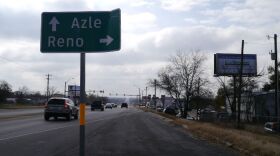Researchers from Southern Methodist University say folks shouldn't rush to conclusions about what's been causing the swarm of more than 30 earthquakes northwest of Fort Worth since November.
Scientists have installed a temporary seismic network in and around the earthquake swarm to help gain a better understanding of the quakes.
On Friday, in the basement of SMU’s Department of Earth Sciences, professors gathered in front of colorful waves from seismic stations.
Professor Brian Stump is part of SMU’s research team. He said those waves are what they use to pinpoint earthquakes, and more carefully examine each acceleration.
“Talking about how earthquakes generate waves,” Stump says. “That may be too technical, but it does help you understand what you’re feeling.”
To understand earthquakes, consider what happens when you drop a rock in a pond, he said.
“You can see the waves spread out from that rock,” Stump says. “And they get farther and farther apart, the farther they propagate. Same thing happens in the earth. The fault slips and it generates waves, but it generates two kinds of waves” -- a “P” wave and an “S” wave. The “S” wave travels slower, he says.
“So you may feel the first ‘P’ wave, which is a pop or a bang, and then you may feel a kind of rolling motion that’s associated with the ‘S’ wave,” he said.
This kind of information will ultimately land in the SMU researchers' North Texas Earthquake Study.
Professor Heather DeShon is the team’s lead scientist. She says one of the big questions is whether there is a relationship between earthquakes and wells, where water is injected back into the earth from nearby oil and gas drilling.
“So we are interested in understanding if the fluid injection points are specifically related to the Azle sequence or the Mineral Wells sequence,” she says. “But it’s important to remember that we do not understand if and how injecting fluid into crust reactivates faults.”
She’s not sure if fluid injection could reactivate faults or if it’s even relevant to the North Texas earthquakes.
“The number of stations we have deployed in Azle, and the diversity of instrumentation we’ve already deployed is really going to provide us an unprecedented opportunity to understand these processes,” DeShon says. “But I’ll stress today, we are still in the data collection point of our study. We do not have results and conclusions.”
Earthquakes are top of mind in and around Azle, considered the epicenter of the recent earthquake swarm. Many residents near Azle blame natural gas well drilling -- and the use of disposal wells to store wastewater from the drilling. There’s been a gas drilling boom in the Barnett Shale, a massive geological formation that covers about 20 North Texas counties.
For Michael Loggains, who lives near the Trinity River north of Azle, the minor earthquakes aren’t as worrisome as the poor water quality. He used to work purifying wastewater from injection wells.
“All of the water purification companies went out of business, because the big oil companies quit hiring people like our company to clean the water up to where it could be put back into lakes, ponds and streams," he said.
He added: "You know, when we was kids, you could get a water hose and drink out of it, and it was fine. Now you can’t do that.”
Loggains hopes by the time the study is finished, scientists will have better answers about why quakes keep shaking North Texas.











